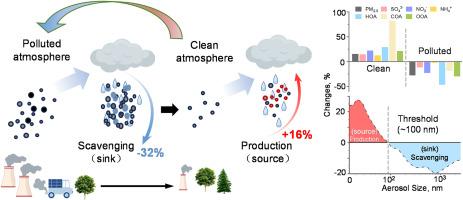揭示降雨在控制环境气溶胶颗粒中的双重作用:从冲刷主导的清除到生产动态
IF 3.7
2区 环境科学与生态学
Q2 ENVIRONMENTAL SCIENCES
引用次数: 0
摘要
湿清除是气溶胶-降水相互作用的关键决定因素,但其对大气气溶胶负荷的净效应在全球范围内仍然缺乏限制。在这里,我们基于一个靠近沿海的亚热带地区的野外观测分析了146次降雨事件,结果显示,小雨使气溶胶负担平均增加了+ 6.1%,疏水物质(如HOA/COA)增加了约+ 40%,次级吸湿成分(如硫酸盐、硝酸盐、OOA)增加了+ 5% - 19%。这与传统的小雨湿扫气知识相矛盾,表明湿扫气效率的模型参数化存在关键缺陷。我们的研究还阐明了一种依赖于污染的湿清除机制,并表明在污染条件下(PM2.5 >30 μg m−3),降水能有效去除气溶胶颗粒,而在非常清洁的大气条件下(PM2.5 > 10 μg m−3),降水使气溶胶浓度升高13% - 100%,这意味着随着未来空气污染的持续改善,降水可能从清除汇转变为气溶胶源。此外,我们确定了一个非线性大小相关的清除阈值为~ 100 nm,其中降水显示从产生到清除细颗粒物的过渡;20 - 30 nm的颗粒表现出峰值增加(+ 23% - 41%),而600 nm左右的颗粒表现出最大的清除率(- 20%),但对于较大的颗粒(例如>;1 μm),清除率意外下降。这些发现强调了降雨在去除气溶胶和增强气溶胶方面的双重作用,为改善空气质量预测和改进气溶胶-云-降水相互作用的模型模拟提供了关键的限制。本文章由计算机程序翻译,如有差异,请以英文原文为准。

Unveiling the dual role of rainfall in governing ambient aerosol particles:From washout-dominated scavenging to production dynamics
Wet scavenging is a critical determinant of aerosol–precipitation interactions, yet its net effect on atmospheric aerosol burdens remains poorly constrained globally. Here, we analyzed 146 rainfall events in total based onfield observations in a subtropical near coastal site, revealing that light rainfall has paradoxically amplified aerosol burdens by +6.1 % averagely, with approximate +40 % for hydrophobic species (e.g., HOA/COA) and +5 %–19 % for secondary hygroscopic components (e.g., sulfate, nitrate, OOA). This contradicts conventional knowledge of light rain wet scavenging, indicating critical flaws in model parameterizations of wet scavenging efficiency. Our study also illustrates a pollution-dependent wet scavenging mechanism and shows efficient removal of aerosol particles under polluted conditions (PM2.5 >30 μg m−3), whereas in very clean atmosphere (PM2.5 <10 μg m−3), precipitation elevates aerosol concentrations by +13 %–100 %, implying that precipitation may shift from a clearing sink to a source of aerosols with the continuous improvement of air pollution in future. Furthermore, we identify a nonlinear size-dependent scavenging threshold of ∼100 nm, where the precipitation shows a transition from production to scavenging of fine aerosols; the 20–30 nm particles show peak increases (+23 %–41 %), while particles of around 600 nm exhibit maximum scavenging (−20 %), yet scavenging declines unexpectedly for larger particles (e.g. >1 μm). These findings highlight rainfall's dual role in aerosols removal vs. enhancement, offering critical constraints for improving air quality forecast and refining model simulations of aerosol-cloud-precipitation interactions.
求助全文
通过发布文献求助,成功后即可免费获取论文全文。
去求助
来源期刊

Atmospheric Environment
环境科学-环境科学
CiteScore
9.40
自引率
8.00%
发文量
458
审稿时长
53 days
期刊介绍:
Atmospheric Environment has an open access mirror journal Atmospheric Environment: X, sharing the same aims and scope, editorial team, submission system and rigorous peer review.
Atmospheric Environment is the international journal for scientists in different disciplines related to atmospheric composition and its impacts. The journal publishes scientific articles with atmospheric relevance of emissions and depositions of gaseous and particulate compounds, chemical processes and physical effects in the atmosphere, as well as impacts of the changing atmospheric composition on human health, air quality, climate change, and ecosystems.
 求助内容:
求助内容: 应助结果提醒方式:
应助结果提醒方式:


